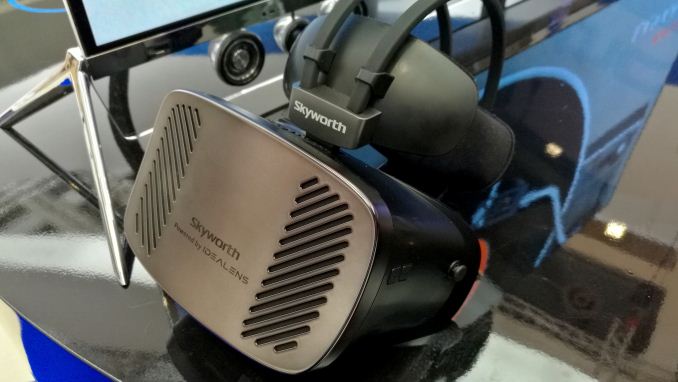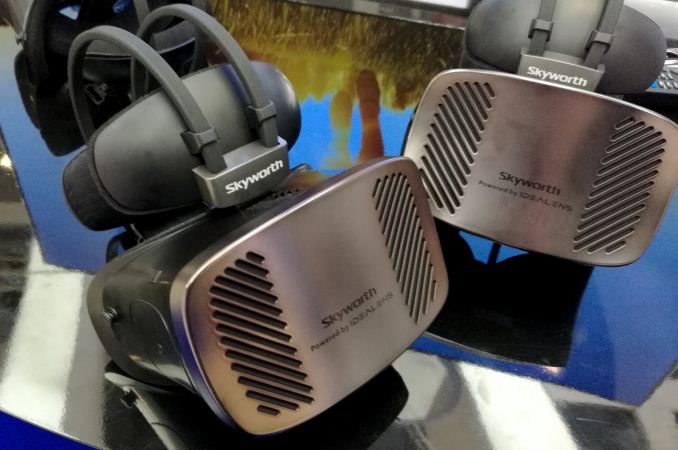IFA 2016: Examining the Malaise of Bargain Basement Virtual Reality
by Dr. Ian Cutress on September 9, 2016 9:00 AM ESTGoing Above $100: The Skyworth AIO-VR
In the last few minutes of the show I was steered towards the Skyworth booth in a different hall and told to go see their all-in-one headset. I was told that in comparison to the others, the Skyworth offering might be a substantial substitute above the cheap VR on display. The problem is always the cost, which we’ll get onto in a minute. The Skyworth VR setup was on display to test, however there were no specifications on display, and we weren’t allowed to take a picture of the image on the demonstrator’s phone that had all the hardware listed, but I was able to memorize a few key points.
It’s worth saying that the Skyworth AIO-VR was slightly bulkier than the other headsets, if only because the mechanism to mount it on your head was a plastic part of the design, aimed at balancing the weight a little but also securing it more firmly with padded guards. The outside was still plastic, however with a brushed metal look, and slightly more attention to detail.
The units were up and powered, and after putting it on I could tell the interface was smooth. Don’t get me wrong, the pixels were still quite obvious, but moving my head showed a high frame rate display better than the 30/60 Hz offerings of the cheaper implementations.
As far as I could jot down in a reasonable time, the headset uses an Exynos 7420, which is a 4x4 big.Little design using quad ARM Cortex A57 at 2.1 GHz and quad ARM Cortex A53 cores at 1.5 GHz on a 14nm process. The 7420 also uses Mali-T760MP8 graphics, at 772 MHz, which is good for 210 GFLOPs, and is paired with dual-channel (2x32-bit) LPDDR4. This SoC was powering dual 1080x1200 displays inside, which is a formidable number of pixels, and I saw that we’re looking at a 3800 mAh battery. Other specifications I can’t remember, though one would assume a 4GB/64GB arrangement for memory and storage if this was a smartphone.
So here’s the thing: the Skyworth headset is essentially a smartphone under the hood that you can’t take out. So what makes it better than a Samsung VR headset where the smartphone can be attached / detatched? One would assume it’s a price thing, and we were told the price for the headset could be $400 to $800. I remarked that it was a pretty large range, but was told that the Skyworth headset is still a work in progress, with exact specifications to be decided later. If it was $400, it might be more palatable, but for $800 then it might be easier to go the smartphone route.
The Problem with Low Cost VR
This brings us around to the problem with VR right now. Everyone wants in on the bandwagon, and in a keynote at the event it was pointed out that in order for triple-A style games and film studios to start making content in these new formats, there needs to be more potential sales out there. Current estimates put 500k headsets in the market (of varying degrees of power) with another 2.7 million by the end of 2017. No game studio or film studio, working on the next FPS or Avatar, will make a massive piece of content for only 3.2 million people – it needs to be in the hands of tens of millions to even start to make sense, and we won’t be at that point for a number of years.
All that being said, you have a choice – investing in a premium VR headset to be able to experience the best will cost $700+, in terms of the headset itself plus any extra hardware you need to power it. The easiest way to enter the VR space with some clout is the smartphone or all-in-one route, but that is still a hefty cost. Then there is a large, long gap to the segment of very basic all-in-one virtual reality headsets as shown at IFA this year.
For $100, or the rough price of the Samsung headset without any internal hardware, you get a basic quad-core Rockchip design with limited functionality. I’m half inclined to suggest that a bucket be provided as well, just in case nausea takes over. But it shows what a state VR is in, when the hardware is still so expensive. In order to get a base experience that can truly be called VR, such as with the Skyworth headset, it might be as much as a high-end smartphone anyway. For mass market adoption, the cost to enter has to be low, but not so low we’re scraping the barrel for basic frame rates.
Picture Galleries















































59 Comments
View All Comments
theduckofdeath - Wednesday, September 14, 2016 - link
I completely disagree on that. PC component reviews are a lot more relevant on Tom's. On here most reviews are basically marketing for equivalent Apple products, which means you get very little reviews or comparisons of components on here.sonicmerlin - Thursday, September 15, 2016 - link
Oh god just shut itfanofanand - Friday, September 9, 2016 - link
Yet another chicken/egg situation. There won't be any killer VR titles until VR is in the hands of millions, but until there are killer titles available the masses won't be buying VR headsets. For whatever reason $200 seems to be a psychological barrier. Once people can get one of these for under $200 as a self-contained unit I don't think we will see widespread adoption. Tethering yourself to a PC will never take off, nor will backpack units. Once we hit 7 nm maybe there will be sufficient economies of scale to make this work but I believe we are at least 5 years out, and in those 5 years I fear VR will follow 3D into the technology graveyard.theduckofdeath - Monday, September 12, 2016 - link
At E3 games like Resident Evil VII, Star Wars Battlefront and Fallout 4 were announced for VR. That is pretty top en AAA if you'd ask me.theduckofdeath - Monday, September 12, 2016 - link
*top endReflex - Friday, September 9, 2016 - link
Is there any chance of getting a look at the OSVR HDK2? Not all of us are intimidated by the configuration hurdles, I just want to know how the quality of the actual experience.Wolfpup - Friday, September 9, 2016 - link
I think the easiest way would be a Playstation 4 + Playstation VR, for something that's apparently real VR, even if it's not as good as the PC based things.Considering the three real VR headsets seem like they're just kind of "good enough" paired with a PS4 or a high end PC, these things running low to mid range phone CPUs are both hilarious, and kind of offensive.
Danvelopment - Friday, September 9, 2016 - link
Did you notice any booths selling tethered VR on the cheaps?PolarisTLX - Saturday, September 10, 2016 - link
Great article providing some handy perspective on this topic which making waves in the tech world. If you absolutely want to experience this today, then you should be ready to buy one if the high end headsets. Otherwise good but cheap headsets are still a couple years away at least.StrangerGuy - Saturday, September 10, 2016 - link
"Current estimates put 500k headsets in the market (of varying degrees of power) with another 2.7 million by the end of 2017"That's lolworthy economics of scale when AMD in it's darkest days can sell at least 10M discrete GPUs a year. Apple can probably sell that many iPhones within the first hour on iPhone launch day.